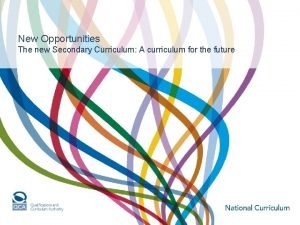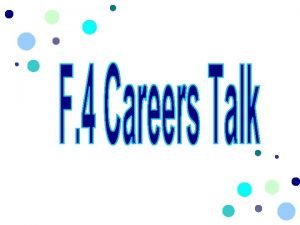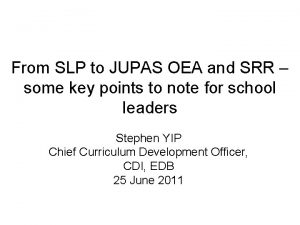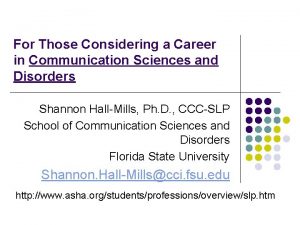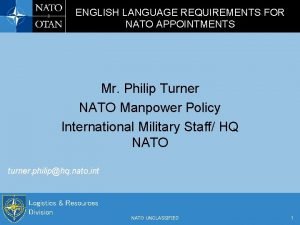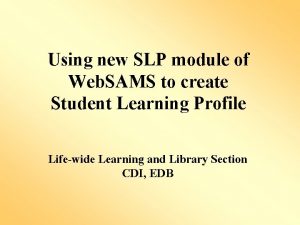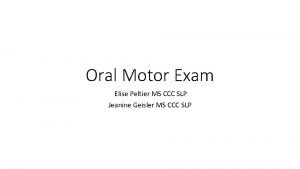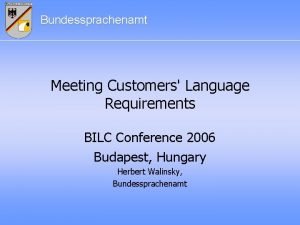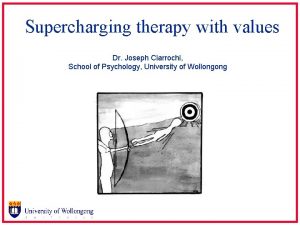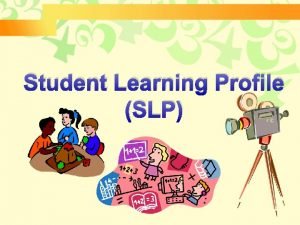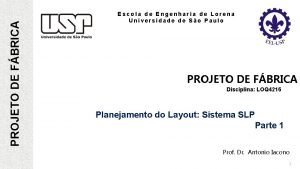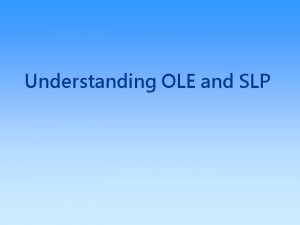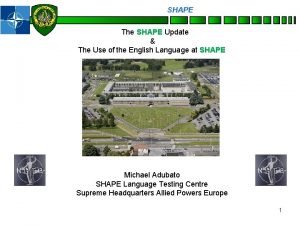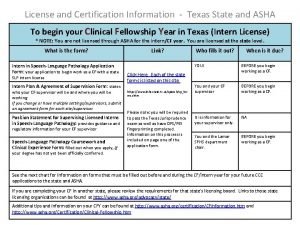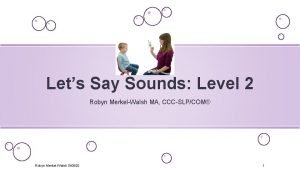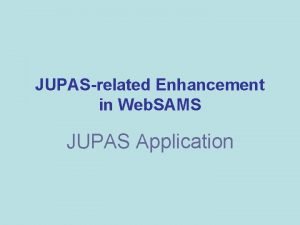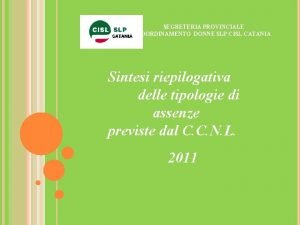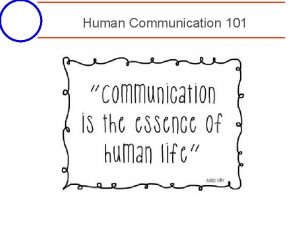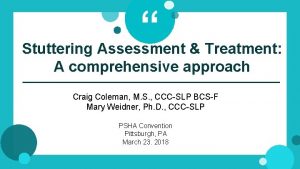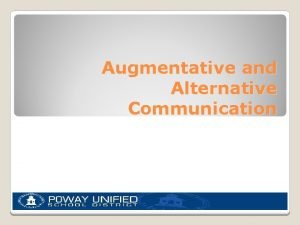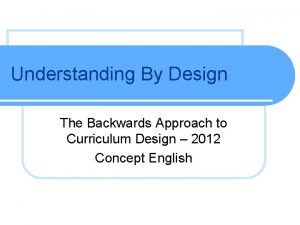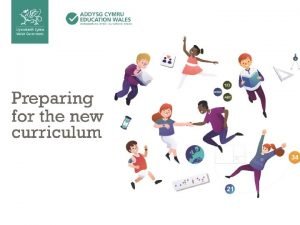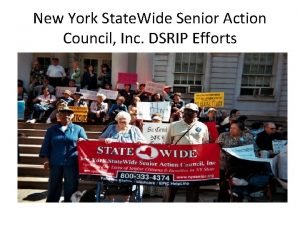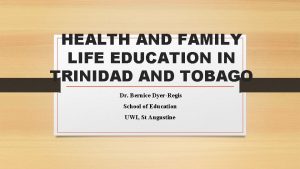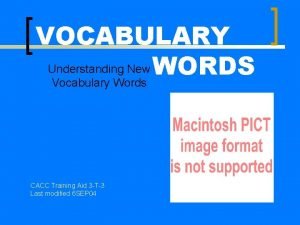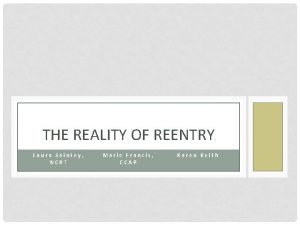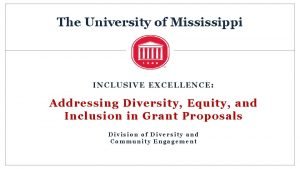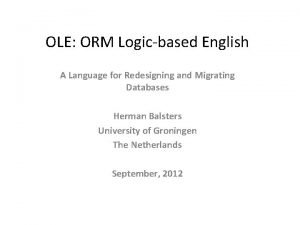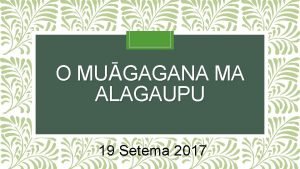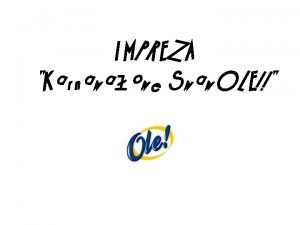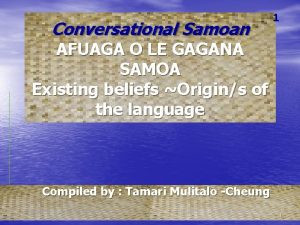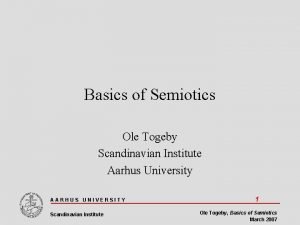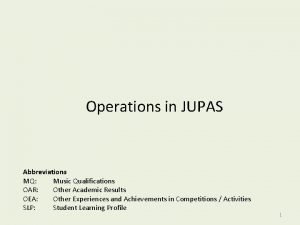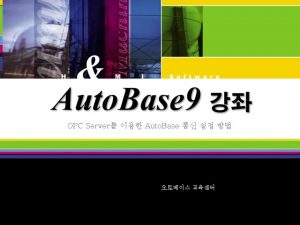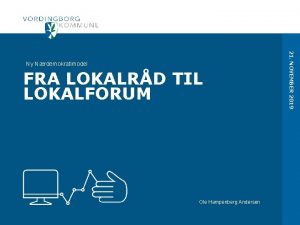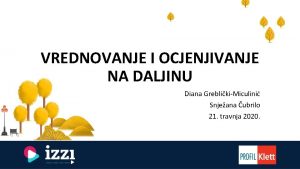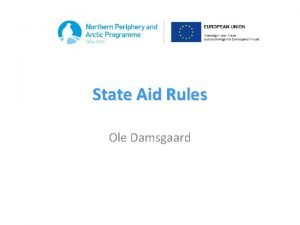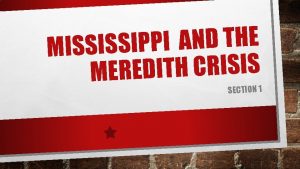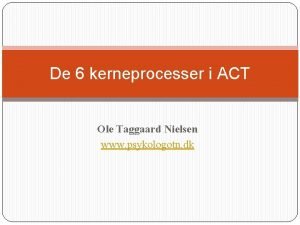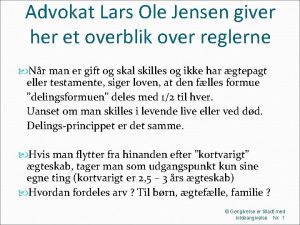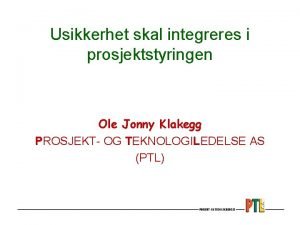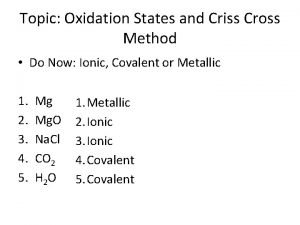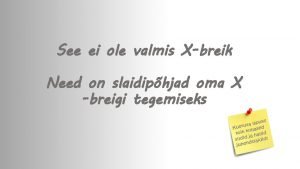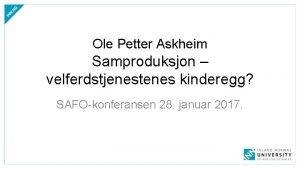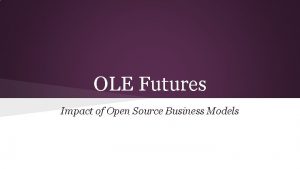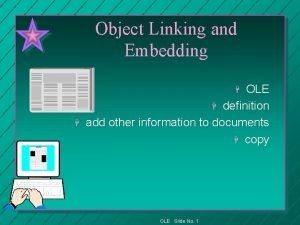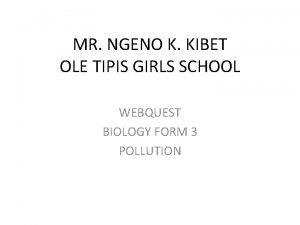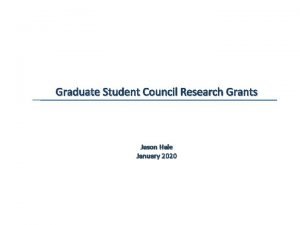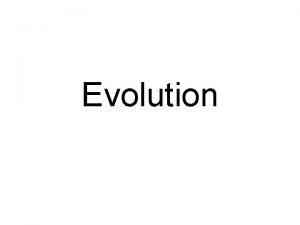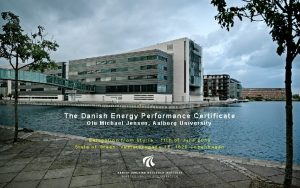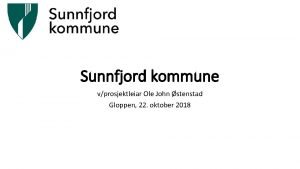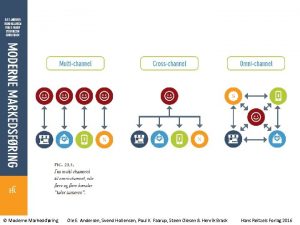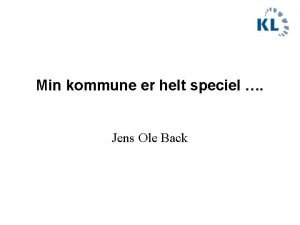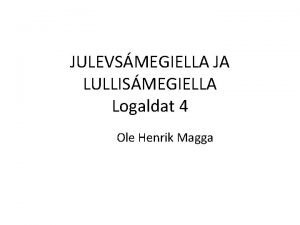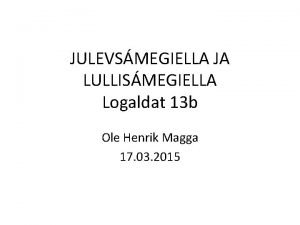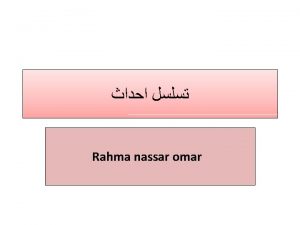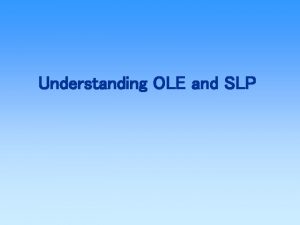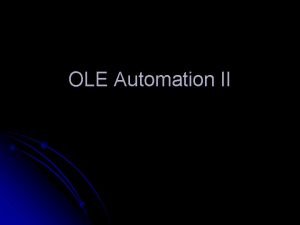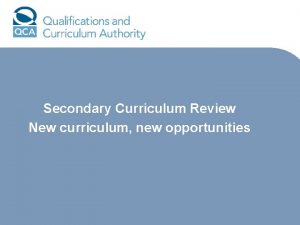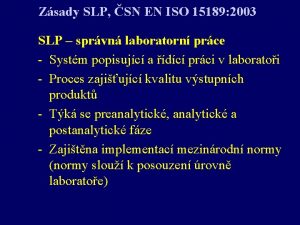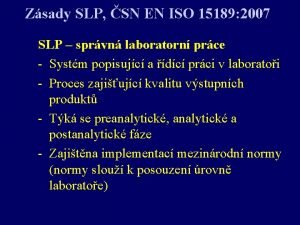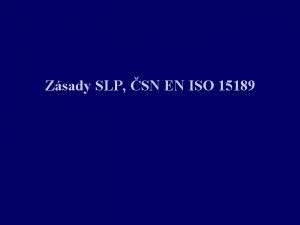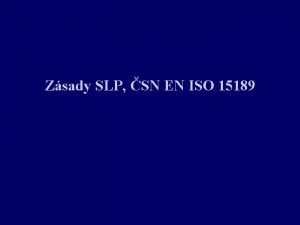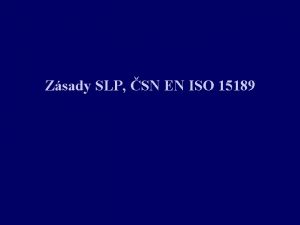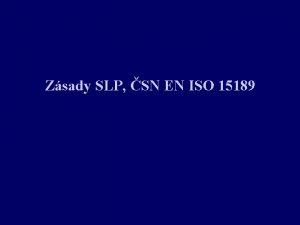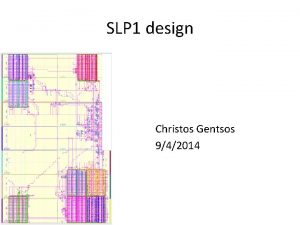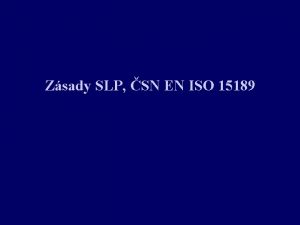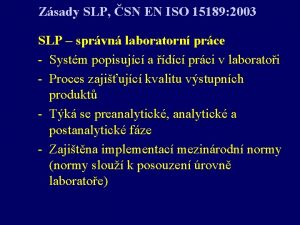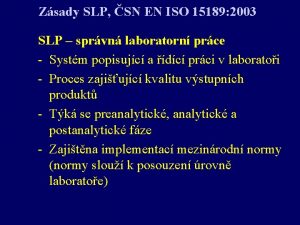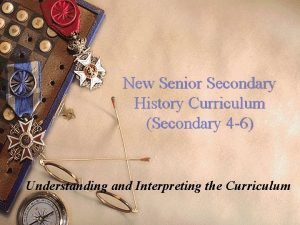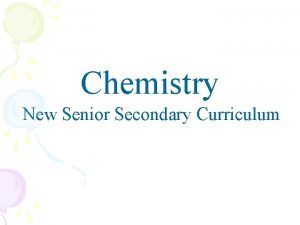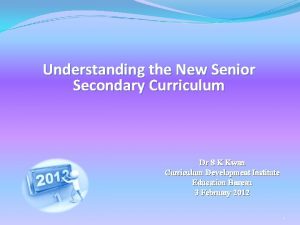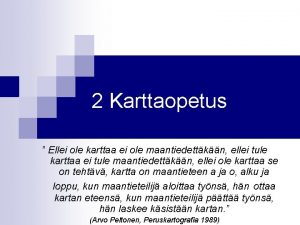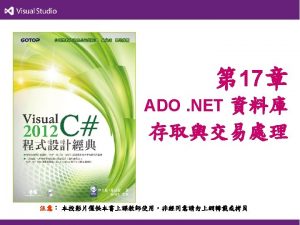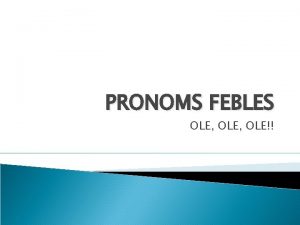New Senior Secondary Curriculum Understanding the OLE SLP


































































- Slides: 66

New Senior Secondary Curriculum ‘Understanding the OLE & SLP’ 6 March 2008 Life-wide Learning & Library Section CDI / EMB

Understanding OLE and SLP • OLE & SLP 源起篇 • OLE & SLP 解碼 – – Positioning in the NSS Curriculum Time arrangement of OLE Why OLE? Seven Guiding Principles & school-based approaches – Student Learning Profile – Web. SAMs as an example tool • OLE Leadership in schools

Other Learning Experiences (OLE) and Student Learning Profile (SLP) in New Senior Secondary Curriculum 源起篇

Reforming the Academic Structure for Senior Secondary Education and Higher Education - Actions for Investing in the Future (EMB, Oct 2004)

Other Learning Experiences suggested time allocation breakdown over 3 years Minimum Hours 1. Aesthetic Development 5% 135 (e. g. music lessons, art performance) 2. Physical Development (e. g. P. E. lessons, sports) 3. Moral and Civic Education (e. g. form tutor lessons, religious education periods) 4. Community Service (e. g. visiting elderly homes, community projects) 5. Career-related Experiences (e. g. career talks, job shadowing) Suggested Minimum 15% 405

Do you agree that other learning experiences should be included as a component of the curriculum ? Strongly Agree + Agree = 84 %

Do you agree that the achievements, qualifications and other learning experiences of a student throughout the years of senior secondary schooling should be recognised by means of a student learning profile ? (476 schools) Strongly Agree + Agree = 87 %

Do you agree that universities should use broader admission criteria, e. g. components in student learning profile? Strongly Agree + Agree = 82 %

The New Academic Structure for Senior Secondary Education and Higher Education – Action Plan for Investing in the Future of Hong Kong (EMB, May 2005)

Major principles of OLE & SLP will be included in the Senior Secondary Curriculum Guide (firstly in web-version) in 2008 Coming Soon

Understanding OLE and SLP 解碼

Building on Strengths of Basic Education: The Whole Curriculum Framework (Coherence, Fullan) 4 Core Subjects: Chinese Language, English Language, Mathematics, Liberal Studies 2 -3 Elective Subjects out of 20 subjects or out of courses in careeroriented studies Other Learning Experiences including (45 -55%) (20 -30%) (15 -35%) moral and civic education, community service, aesthetic and physical development, careerrelated experiences NSS Generic Skill Value & Attitude P 1 - S 3 General Studies Moral and Intellectual Community Physical & Career-related Aesthetic Civic Development Service Development Experiences Education

Proposed NSS Curriculum Chinese Language, English Language, Mathematics and Liberal Studies as core subjects for ALL students 2 or 3 elective subjects (chosen from a range of 20 elective subjects) Career-oriented studies (alternative(s) to elective(s)) Other learning experiences (moral and civic education, community service, aesthetic and physical development, career-related experiences) 45 – 55% 20 – 30% 15 – 35%

Other Learning Experiences (suggested time allocation breakdown over 3 years) Minimum Hours 1. Aesthetic Development 5% 135 2. Physical Development 5% 135 3. Moral and Civic Education 4. Community Service 5. Career-related Experiences

Time Arrangement of Other Learning Experiences(OLE) • OLE could be arranged within and outside normal school hours. • Instead of rigidly allocating lesson time into a fixed number of lessons per week/ cycle, schools are encouraged to have an overall and flexible planning of lesson time for students throughout the three years of senior secondary education. For example……. .

For example: • Career-related Experiences and Community Service could also be arranged after-school, post-examination, weekends, before or during vacations if required • Aesthetic Development, Physical Development are most likely implemented in the form of structured lessons while Moral and Civic Education would commonly make use of the class teacher’s periods or assemblies. They could be flexibly built into both ‘weekly/ cycle’ timetable and other timeslots (e. g. an afternoon during weekdays, after school or Saturday) to ensure that students could have the full opportunities to gain the experience. School examples

Example one: School A Within Normal School Hours (Proposed time-table for the NSS) Secondary 4 • PE lessons + structured programmes (40 hrs) – PE • Class teacher period (20 hrs) - MCE • Building on the existing practice, insert three sessions for OLE programme (Creativity / Art Workshop* - 40 hrs) The content of the workshop will include all five components of the OLE *work with an outside NGO

Outside Normal School Hours Activity curriculum (50 hours approx. ) The activity curriculum covers the activities of five domains. They are - Arts Interest Sports/PE Leadership Services 10 compulsory ECA sessions (20 hrs) + self-managed time (30 hrs) As a policy of ECA, students are required to participate in every domain throughout the three years of school life. Totally ‘ 50 hrs participation’ is the recommended indicator (10 hrs on average for each domain). OLE hours = 40 + 20 + 40 + 50 = 150 hours (150+105= 405 hr)

The time table PE lesson Class Teacher period Creativity / Art workshop Proposed practice

Example two: School B Within Normal School Hours Secondary 4 - PE lessons (40 hrs) - PE - Assembly / Class teacher period (40 hrs) - MCE - Arts Education (e. g. Music, Visual arts ……) (20 hrs) - AD - Religious Education (40 hrs) - MCE Outside Normal School Hours Extra-curricular Activities(ECA)……

Assembly Music Lesson PE Lessons RE Lessons

More than 40 Extra-curricular Activities: • Art and Photography Club • Astronomy Club • Charity Committee • Chinese Society • Christian Fellowship • Community Youth Club • Dance Club • Girl Guides…… Every student is required to participate in at least X numbers of Extra-curricular activity. OLE hours = 40 + 20 + 40 + ECA = above 150 hrs (150+105=405 hr)

Why OLE? Expected Outcomes of OLE q Whole Person Development: A balanced development Chinese virtues (Ethics, Intellect, Physical development, Social skills and Aesthetics) q Complement the examination subjects/ careeroriented studies q Building up life-long capacities: ü To nurture informed & responsible citizenship ü To respect for plural values ü To adopt a healthy living style ü To develop career aspirations and positive work ethics


Through these learning experiences, to nurture… Five Core Values: Generic Skills: e. g. • • • Perseverance Respect for Others Responsibility National Identity Commitment Communication Creativity Critical Thinking Collaboration

Seven Guiding Principles of Designing School-based OLE Schoolbased Models

Existing Curricular Arrangement Approaches Event-based Approach Structure Curriculum-based Approach OLE Programmes Low Pre-defined Content High Pre-defined (apart from Sessions / formal lessons in AD, PD, MCE) Project-based Approach Low Structure Content Activity-based Approach

This approach aims to design a highly structured, ‘pre-packaged’ curriculum to incorporate most elements in OLE. Schools adopting this approach, usually have a strong tradition in testing out the curriculum among teachers through years.

This approach is usually adopted to create a structured framework/ ‘scaffold’ for slotting different kinds of activities for OLE into the school timetable. The strengths of this approach is its flexibility to change any programmes relatively easily due to changes of situations over time. Strong staff consensus is needed

This approach is distinguished from the ‘pre-packaged’ Curriculum-based approach, by its non-sequential nature for OLE. NSS students would have the flexibility to a wide variety of activities. Usually schools will have a strong ECA tradition and policy to ensure entitlements and quality.

This approach is adopted when schools have been enjoying a strong project learning culture in junior secondary students. Four main elements are usually found in implementing OLE, engagement, fun, learning, and ‘products that matter’ (from Harvard Project Zero). Good for filling identified ‘gaps’.

Flexibility- An AD Example • • d e s a l-b o o h le c s b a s A t n r i a A It is worth noting that the &suggested minimum time allocation* is sust ent on to provide schools with guidance in planning and implementing OLE, pm tion o l e dev educa in terms of curriculum time. Schools could implement Aesthetic Development (AD) in accordance with their own situation. The best way to deliver AD is to provide students with structured learning sessions, which are complemented with authentic arts activities outside the classroom. e. g. structured learning sessions - music and/or visual art lessons, seasonal structured arts programmes, structured arts learning days. e. g. authentic arts activities- extra-curricular/co-curricular activities and interest groups. However, the ratio between structured learning sessions and the related activities need not be rigid. What is more important is that schools should provide quality arts learning opportunities for their students.

Student Learning Profile (SLP) For Senior Secondary A key to future success…… ‘Students telling their own stories’

Every student is encouraged to build a Student Learning Profile SLP

What could be in the SLP? e. g. 1) Personal Particulars of the student 2) Academic performance in school (i. e. from school report cards) 3) Information of Other Learning Experiences 4) Participation and awards gained outside schools (if appropriate) 5) ‘Student’s Self-Account’ (if appropriate) on e g in ctic d l i Scho u ra B P ol-ba se i g c n o n C i sed d t Basic & tion esign exis and p orma f n i roces s

Aims of the SLP: ü Reflects a concern for whole-person development ü To motivate learning and engagement ü To recognize non-academic achievements ü To give employers and higher education institutions a more complete picture of the individual and his/her achievements

Other Learning Experiences Student Learning Profile (e. g. ) • Aesthetic Development • Participation • Physical Development • Achievements • Moral & Civic Education • Reflections • Community Service • Career-related Experiences • Attributes and Capabilities ic s a B y n r o i e t V a m r Info

What are the existing school-based practice ? • Most schools claimed they have their own system for OLE recording OLE inside the academic report • Using different report sheets (non-academic reports) • Multiple intelligence ‘Passport’ • Portfolio for on-going reflection • Record inside the Student Handbook • Powerful on-line system • Learning diary ……. .

Student led, recording orientated Teacher led, recording orientated Student led, reflection orientated Teacher led, reflection orientated

Will SLP be considered in the university admission? “Universities will consider taking account in their selection a broader range of information of student achievements in different areas and provide students the opportunity to demonstrate that they possess the range of competencies and personal qualities that they will need to benefit from undergraduate education. Schools will assist students to develop the SLP to provide comprehensive information about students’ performance in different areas and hence SLP has good reference value to universities. ”

Web. SAMS SLP Template l m a x e As o o t ple

Student Particulars

Academic Performance in School Understanding inschool performance in academic subjects Knowing the topics of projects involved.

Other Learning Experiences What role did the student involved in the activity Description shows knowledge, generic skills, values and attitudes developed through the experience. What evidence the student has in each activity/programme? Which kind(s) of experience on each activity?

Awards and Major Achievements issued by School Information on awards and achievements issued by the school

Performance / Awards and Key Participation Outside School No need for school to validate the information SLP readers could ask student to produce evidence against each entry

Student’s ‘Self-Account’ Additional Information about the students’ personal development May include information of major achievements in junior forms

Leadership of OLE Celebrating Whole Person Development

Forming a co-ordinating team Auditing the existing ‘Getting Started’ Suggestion Filling the gaps (‘do’s and ’don’t’s) Communication strategies (in and out of schools) Making good use of resources & partnerships Monitoring/ celebrating the quality of programmes …

Learning-centred Leadership in OLE: Three Learning Agendas & Contexts Student Learning Professional Learning System Learning School contexts Community contexts Policy and professional contexts

Distributed Leadership • • More than shared leadership or delegation Involves formal and informal leaders Web of leaders; connected leadership It is interaction that matter; not roles and positions Outcomes: • People have contribution to make • Willing followers ‘Leader-ful Organisation’ • More sustainability ‘Leader-ful Community’

重質不重量 Three notions from Dewey: Educational experience, non-educational experience, mis-educational

Quality of OLE • • Quality of learning experience Quality of organisation Quality of partnership Quality of space



Quality of Space Character Story Blending Confidence


http: //www. edb. gov. hk/cd/ole

活動資料庫(Activity Data Bank)

學校推行示例(School Exemplars)

學生學習概覽(Student Learning Profile) 具(Tools) 範本(Templates)



SLP is assessment OLE does not OLE = ECA include ECA OLE means Only teachers abolishing PE Highly structured could take up lessons programme OLE means high Some quality common Myths/ CS means visits Related Misunderstandings to Elderly experiences gained Experiences about OLE & SLP homes from subjects do gained from not count ECA has less Meeting hours quality ‘OLE entitlements’ requirement is mean everyone have all we need in OLE needs to participate the OLE grading same programmes CRE means only work attachment All OLEs have to be highlystructured and in the lesson timetable

“Education is not simply a technical business of wellmanaged information processing, not even simply a matter of applying ‘learning theories’ to the classroom or using the results of subject-centered ‘achievement testing’. It is a complex pursuit of fitting a culture to the needs of its members, and its members and their ways of knowing to needs of the culture. ” (Jerome Bruner, The Culture of Education, 1966, p 43) What is Education?

OLE is about winning hearts… The Heart… The Priority Aim of ‘OLE’
 New academic structure
New academic structure New secondary curriculum
New secondary curriculum Slp jupas sample
Slp jupas sample Slp jupas
Slp jupas Fsu slp bridge program
Fsu slp bridge program Acoact
Acoact Sams slp
Sams slp Slp oea
Slp oea Oral mechanism exam slp
Oral mechanism exam slp Bundessprachenamt slp test
Bundessprachenamt slp test Slp dominance
Slp dominance Slp profile
Slp profile Slp
Slp Nss slp
Nss slp Dogboss bsc
Dogboss bsc Personnel
Personnel Slp dse
Slp dse Texas slp jurisprudence exam
Texas slp jurisprudence exam Robyn walsh slp
Robyn walsh slp Slp jupas
Slp jupas Slp 3332
Slp 3332 Slp cisl catania
Slp cisl catania Definition of human communication
Definition of human communication Craig coleman stuttering
Craig coleman stuttering Vmware cim slp
Vmware cim slp Multiversidad latinoamericana slp
Multiversidad latinoamericana slp Slp consult
Slp consult Understanding by design curriculum
Understanding by design curriculum Prescriptive curriculum
Prescriptive curriculum New york statewide senior action council
New york statewide senior action council Secondary education commission
Secondary education commission Hfle curriculum trinidad
Hfle curriculum trinidad Understanding new words
Understanding new words The new understanding
The new understanding Young living starterset
Young living starterset Ole miss diversity
Ole miss diversity Ole orm
Ole orm Alagaupu faasamoa ma uiga
Alagaupu faasamoa ma uiga Scenariusz imprezy
Scenariusz imprezy Jason hale ole miss
Jason hale ole miss Afuaga ole gagana samoa
Afuaga ole gagana samoa Ole
Ole Ole taggaard nielsen
Ole taggaard nielsen Oea jupas sample
Oea jupas sample Ole db to opc
Ole db to opc Ole hampenberg andersen
Ole hampenberg andersen Uniknæ
Uniknæ Ole i trufa analiza
Ole i trufa analiza Ole damsgaard
Ole damsgaard Harry s murphy ole miss
Harry s murphy ole miss Ole taggaard nielsen
Ole taggaard nielsen Lars lilholt formue
Lars lilholt formue Ole jonny klakegg
Ole jonny klakegg Criss cross method in chemistry
Criss cross method in chemistry Ole
Ole Ole petter askheim
Ole petter askheim Kuali ole
Kuali ole Define object linking and embedding
Define object linking and embedding Ole tipis girls
Ole tipis girls Infoready uark
Infoready uark /watch?v=tmyf6ewi7e8
/watch?v=tmyf6ewi7e8 Ole michael jensen
Ole michael jensen Ole john østenstad
Ole john østenstad Ole e andersen
Ole e andersen Ole back
Ole back Giergev
Giergev Geniness
Geniness

